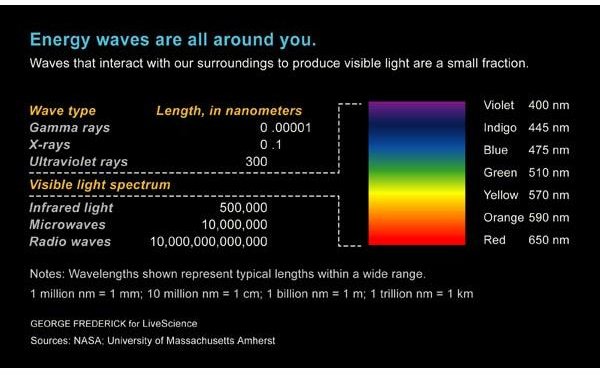Night Sky: What We Can See Compared to Satellites and Telescopes
Seeing the Night Sky with Our Naked Eyes
With an unaided eye we view our universe through a very small window, from blue light to red light. The “big” window is the electromagnetic spectrum. This band, or range of electromagnetic energy exists from extremely long radio waves, which have a wavelength on the order of miles, to the extremely energetic gamma rays that are some 40 million times smaller than the wavelengths of blue light we can see. Our little window into this vast continuum extends from red light that has wavelengths around 700 nano-meters (nm—a billionth of a meter) to about 400 nm for blue light. The figure to the right will help to understand just how small our visual window is in the electromagnetic spectrum. So when we look up into the night sky and see the stars sparkling above, we are only seeing a very tiny piece of what is out there. How about an example?
To illustrate our visual limitations let’s take a look at a simple example—an electric stove. If you turn the burner on LOW, the heating element has the same blackish-gray color it does when it is off. But hold your hand near it and you can feel the heat—infrared energy—wavelengths longer than the red color we can see. So in this case your eyes are not providing you the essential information needed. You need another sense to tell you the heating element is on; fortunately, the nerves in your hand are sensitive to the longer wavelengths of light and you feel the heat. If you turn the burner up to HIGH, you will see it begin to glow a deep red as it emits more energy that now reaches into the visible portion of the electromagnetic spectrum. You’ve probably experienced the same phenomenon when you placed your hand on the hood of a car that has been sitting in the sun. The metal is very hot, yet you had no visual indication that there was heat there. Some insects and animals have visual ranges that extend into the infrared (IR)—like mosquitoes homing in on our warm blood. Bees are able to see in the ultraviolet (UV) band and their view of the flowers they pollinate is very different from what we see because of how the flower petals reflect the UV wavelengths.
When we look at the night sky, we see the pinpoints of light from the stars, some of which may appear bluish or reddish but most will be brilliant white. If you’re lucky, there may be some planets visible and they too will appear to be white in color, except for Mars, which has a definite red tint to it. When we look at the pictures from the Hubble Space Telescope we see glorious pictures in vivid color. Some of these may be natural and others may have their colors enhanced to bring out details in the object that would otherwise go unnoticed. The use of film or nowadays, CCD cameras (like you have in your digital camera) in astronomy allows astronomers to gather color information by collecting the individual photons of light over long periods of time and building an image of the galaxy or nebula that shows colors and details our eyes cannot see in these dim objects.
Viewing Invisible Objects with X-Ray Images
So, do these visual images show us everything that is out there? For a dramatic answer to this question take a look at figure 2 below.
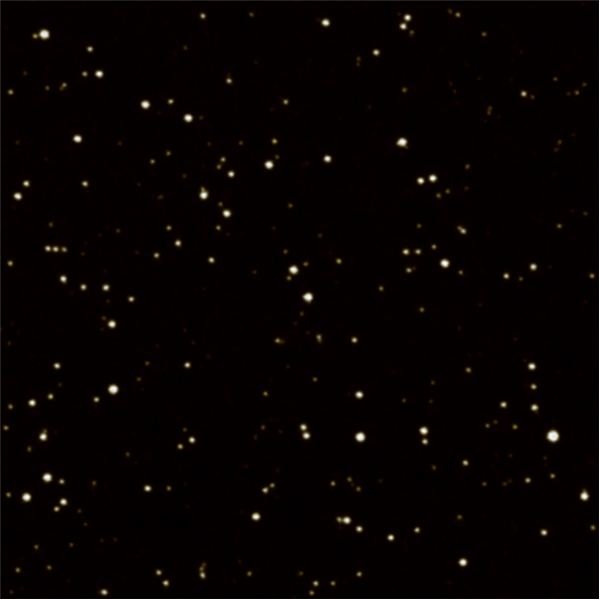
This looks like a picture of a star field but it’s really a cluster of galaxies—known by the descriptor: 3C438—about 4.8 billion light years distant, taken in the visual spectrum. Now, take a look at figure 3.
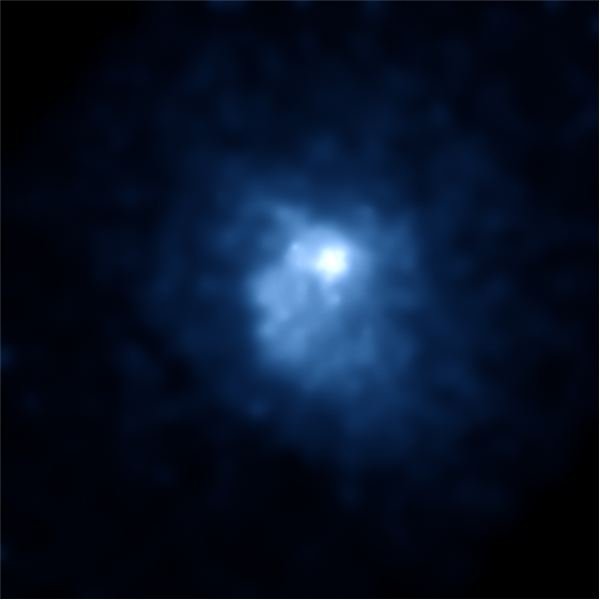
These two pictures are of the same exact region of space but figure 3 is showing the view in the X-ray portion of the spectrum! Figure

4 to the left shows these two images side by for easier comparison, and figure 5 shows them superimposed. It’s difficult to believe that these two images are of the same region. What we are seeing in the X-ray image is tremendously hot gas that permeates the cluster (about 170,000,000 degrees C by some estimates!). This
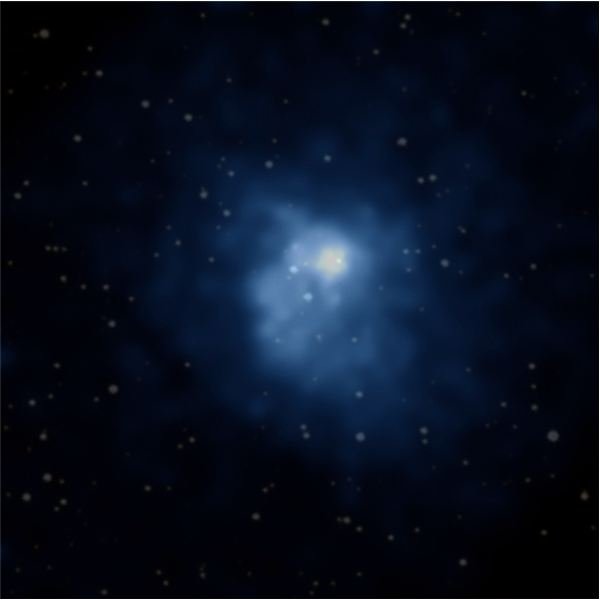
gas is so hot that it emits energies in the X-ray band. Remember the stove example and how the burner was visible in the red region when it was turned on high? Well, imagine if you could keep pumping energy into the burner. It would radiate energy at shorter and shorter wavelengths (higher and higher frequencies) going from red to blue to ultraviolet to X-rays. If it were not for the ability to measure these very high energies we would know nothing of this hidden structure within the galaxy cluster 3C438.
The piece of technology that provides us with this view into the universe is the Chandra X-ray
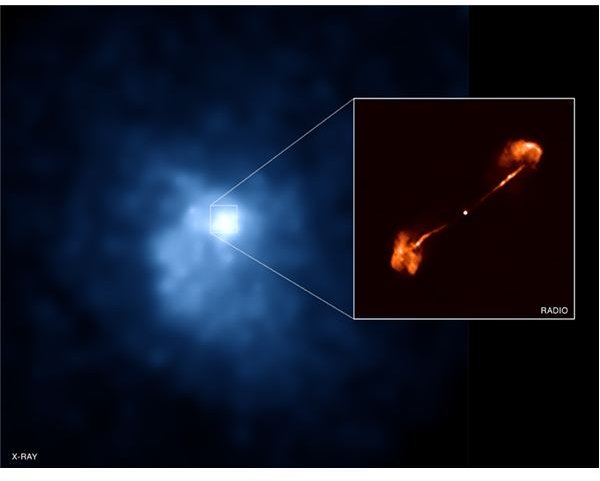
Imaging Observatory, traveling around the earth in an elliptical orbit reaching some 139,000 km (86,500 mi) above our planet. One last image to note is figure 6 to the left. If we go to the other end of the spectrum towards much longer wavelengths— radio waves, we see even more structure inside this cluster. Jets of energy radiating in opposite directions appear in this view provided by National Radio Astronomy Observatory’s (NRAO) Very Large Array. The more observations astronomers can make in different regions of the electromagnetic spectrum the easier it is for them to understand just what they are seeing. It’s like putting a puzzle together that you’ve lost the box cover to. You don’t know what the puzzle is about but the more pieces you snap together the better your understanding of what the picture should look like. (Check this link for more information on 3C438 and Chandra.)
Galaxies
Let’s move on to another image of a fascinating and beautiful galaxy called the Sombrero galaxy (M104), figure 7.
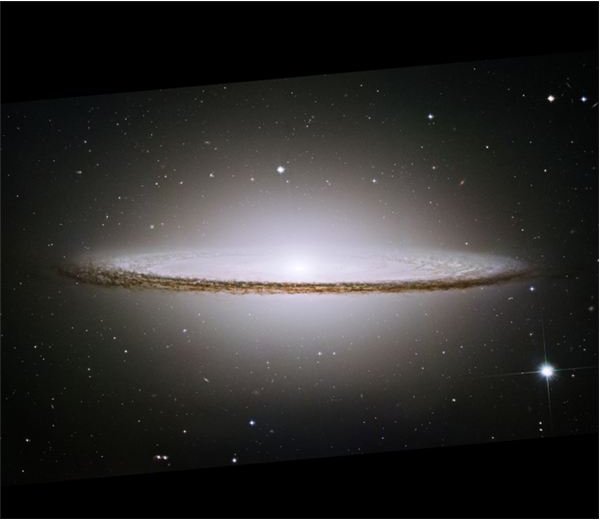
In figure 8, to the left, we see a composite picture of the X-ray, visual, and infrared images of the galaxy. Each piece of the picture conveys information about the energies present and therefore more information as to the structure and composition of the galaxy. The X-ray image shows high-energy emissions of high temperature dust and gas particles in and about the galaxy. Some of the bigger blue dots are distant quasars while others belong to the galaxy. The visual image shows us the huge bulge of stars shining brightly except where thick dust blocks the light along the rim of the galaxy, which we are seeing edge on.
When we move to the infrared image, taken by the Spitzer Infrared Telescope, we see the particles, dust, and stars that are emitting energy in the cooler, longer wavelengths. The band of dust that blocks the optical light along the
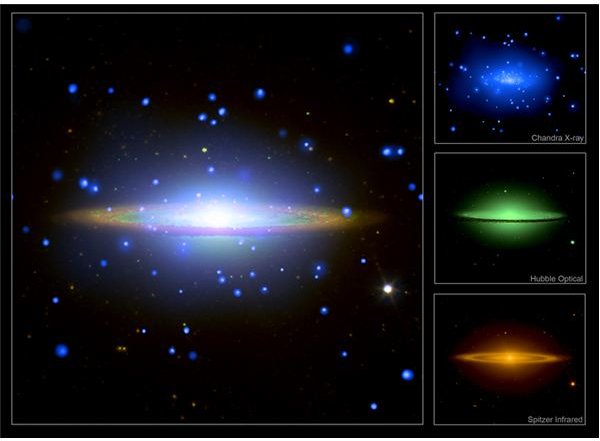
edge of the galaxy now shines brightly as it reradiates the energy it absorbed from the stars in the infrared. There is definitely more there than meets the eye—visually that is!
The next image, figure 9, shows the beautiful spiral galaxy, M81. Note that in this composite we now have an image taken in the ultraviolet region of the spectrum. This shows energies that are lower than X-rays but higher than the visible wavelengths. The X-ray image is dramatically different from the other views indicating an active black hole at the center of the galaxy.
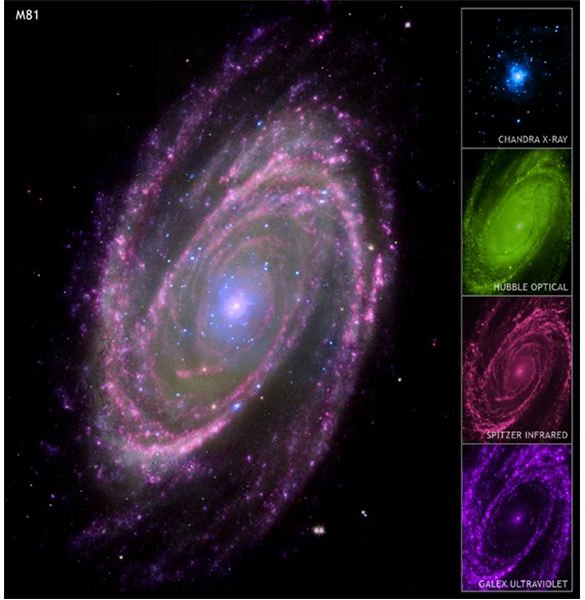
Nebulas
Finally, figure 10 is an image of a nebula where stars are forming, the Trifid Nebula (M20). In this composite you see the beautiful visual image next to a composite of two images taken at two different wavelengths in the infrared spectrum. This provides a finer detail of the energy distribution within the nebula allowing astronomers to piece together the process of how the dust and gas coalesces, forming the stars in this star incubator.
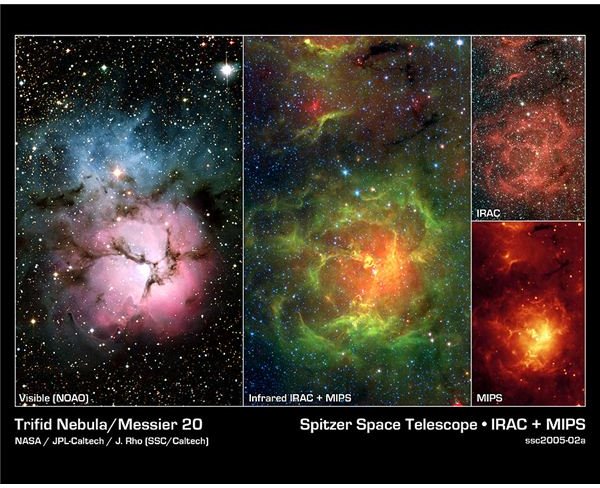
I hope this has given you a hint of the wonderful mysteries that exist in this universe we live in. So the next time you look up at the night sky and wonder and marvel at what you see, think about what’s there that you can’t see!
Credits
Figure 1: https://www.livescience.com/strangenews/070226_about_light.html
Figure 2: Credit: NASA/CXC/CfA/R.P.Kraft
Figure 3: Credit: NASA/CXC/CfA/R.P.Kraft
Figure 4: Credit: X-ray: NASA/CXC/CfA/R.P.Kraft; Optical: Pal.Obs. DSS
Figure 5: Credit: NASA/CXC/CfA/R.P.Kraft
Figure 6: Credit: Radio: NRAO/VLA/A.H.Bridle & R.G.Strom; X-ray: NASA/CXC/CfA/R.P.Kraft
Figure 7: Credit: NASA/STScI/AURA/Hubble Heritage
Figure 8: Credit: X-ray: NASA/UMass/Q.D.Wang et al.; Optical: NASA/STScI/AURA/Hubble Heritage; Infrared: NASA/JPL-Caltech/Univ. AZ/R.Kennicutt/SINGS Team
Figure 9: Credit: X-ray: NASA/CXC/Wisconsin/D.Pooley & CfA/A.Zezas; Optical: NASA/ESA/CfA/A.Zezas; UV: NASA/JPL-Caltech/CfA/J.Huchra et al.; IR: NASA/JPL-Caltech/CfA
Figure 10: https://gallery.spitzer.caltech.edu/Imagegallery/image.php?image_name=ssc2005-02a
